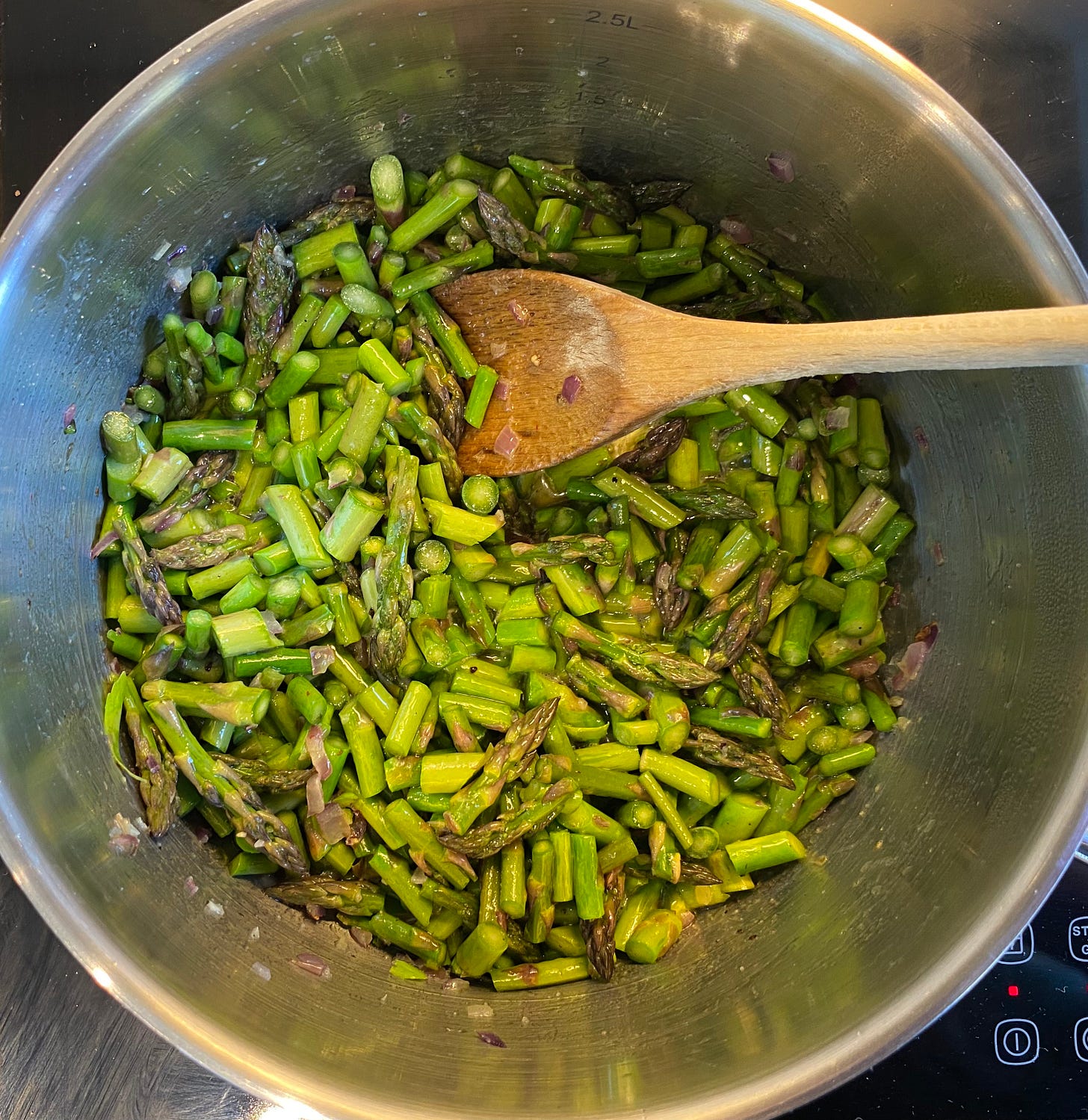Hello, readers! I am on vacation this week, so please enjoy this short post, and see you next week!
Let other countries mark the beginning of spring with the appearance of the first robin. In Switzerland, we know spring is finally here when the cows emerge from the barn and gallop1 into the pasture.

Here’s another cow photo, which I took at the same spot (but from a different angle, to show off more of our glorious Alpine view) a few days ago:
My own eccentric sign of spring is when asparagus reappears in grocery stores. Below is one of my favorite posts, for one of my favorite times of year, Spargelzeit:
Spargelzeit!
Tiny, prosperous, neutral Switzerland is known as a peaceful, harmonious country, but for the past several weeks a controversy has roiled the nation. Outraged editorials have been published, petitions are being signed—perhaps even at this very moment—and laws have been proposed, all to put a stop to this dire practice. Are you curious about what could p…
Last week, asparagus was on sale, but only in very large bunches. I couldn’t resist, so I bought a sheaf that was the size of a chubby dachshund. When I got home and surveyed my purchase, I thought to myself, “Oh dear. Even I can’t eat this much asparagus.” Soup to the rescue! I scoured the internet for ideas and culled the best ones from various online asparagus soup recipes2 to create the following dish:
Cream of Asparagus Soup
This lovely soup is vegetarian and gluten-free. It is quick and easy to make and serves eight as an elegant first course or, with a salad and some crusty bread, it makes a light dinner for four. Plus it uses up your enormous sheaf of asparagus.
Ingredients
2T (30gms) each unsalted butter and olive oil—or more, if that’s how you roll
1 small red onion, finely chopped
1 small clove garlic, finely minced with 1/2tsp salt to make a paste
Freshly-ground black pepper and some additional salt
1-1/2lbs (750gms) asparagus
A hefty splash of dry white wine (about 1/2c, or 100ml)
2c (about 500ml) vegetable stock, either store bought or homemade (here is my recipe)
Several stems of Italian flat-leaf parsley and two or three stems of fresh dill
A glug of heavy cream, to taste (I use about 1/2c, or 100ml)
1 lemon
Method
Prepare the asparagus. Snap off and discard the woody ends and then chop the asparagus into small pieces.
Heat the butter and olive oil in a soup pot over medium-high heat and then sauté the onion, stirring occasionally and sprinkling a bit of salt over it to help it purge its juices. Add in the garlic and some black pepper and sauté briefly. Don’t let the garlic brown.
Dump the asparagus into the pot and toss to coat. Cook, tossing occasionally, until the asparagus has turned bright green, and then pour the wine over it and bring to a boil.
Prepare the herbs: Remove and discard the stems and chop the leaves. Divide in half and add one half of the herbs to the pot. Set aside the remaining half for the topping in step 8.
Add in the stock and bring the soup back to a boil. Lower the heat to low, cover the pot, and simmer for half an hour or so.
Purée the soup with an immersion blender or in batches in your food processor (if you use a processor, return the soup to the pot).
On low heat, add in the cream and, if necessary, adjust the seasonings. Heat just until the soup is warmed through, and then ladle it into warmed bowls.
Top each bowl with the remaining herbs, and then grate a bit of lemon zest over each bowl. Quarter the lemon and serve the soup with lemon on the side, to squeeze over the soup.
How about you, readers? Are you doing anything fun for spring break? What is your favorite sign of spring? Please share your thoughts in the comments!
The Tidbit
Christians don’t sing hallelujah during Lent, but last Sunday was Easter, so—another sign of spring—the hallelujahs have returned. This motet, an arrangement of a Shaker hymn, is 150 seconds of pure joy.
Yes, cows gallop, and they caper too. It is adorable.
For example, many recipes tell you to make a roux to thicken the soup. Why?! In my opinion a roux risks covering up the delicate flavor of the asparagus. On the other hand, some recipes included dill, an excellent suggestion that I have adopted.








Happy Vacation! Your post made me think of my favorite asparagus story, from Proust's REMEMBRANCE OF THINGS PAST. He describes one summer in the country when his family's cook served them asparagus all summer long. The asparagus sounds positively ethereal and almost alien due to the beautiful language he uses to characterize this lovely vegetable. There is, however, a twist. The kitchen maid was allergic to asparagus and the cook did not like her. The cook served asparagus all summer long not because it was beautiful and exquisitely tasty, but solely to torment the maid. Pages and pages of descriptions of asparagus proceed until the punch line arrives. From the sublime to the ridiculous indeed.